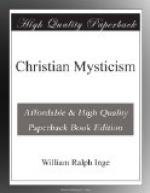We now come to St. Augustine himself, who at one period of his life was a diligent student of Plotinus. It would be hardly justifiable to claim St. Augustine as a mystic, since there are important parts of his teaching which have no affinity to Mysticism; but it touched him on one side, and he remained half a Platonist. His natural sympathy with Mysticism was not destroyed by the vulgar and perverted forms of it with which he was first brought in contact. The Manicheans and Gnostics only taught him to distinguish true Mysticism from false: he soon saw through the pretensions of these sectaries, while he was not ashamed to learn from Plotinus. The mystical or Neoplatonic element in his theology will be clearly shown in the following extracts. In a few places he comes dangerously near to some of the errors which we found in Dionysius.
God is above all that can be said of Him. We must not even call Him ineffable;[194] He is best adored in silence,[195] best known by nescience,[196] best described by negatives.[197] God is absolutely immutable; this is a doctrine on which he often insists, and which pervades all his teaching about predestination. The world pre-existed from all eternity in the mind of God; in the Word of God, by whom all things were made, and who is immutable Truth, all things and events are stored up together unchangeably, and all are one. God sees the time-process not as a process, but gathered up into one harmonious whole. This seems very near to acosmism, but there are other passages which are intended to guard against this error. For instance, in the Confessions[198] he says that “things above are better than things below; but all creation together is better than things above”; that is to say, true reality is something higher than an abstract spirituality.[199]
He is fond of speaking of the Beauty of God; and as he identifies beauty with symmetry,[200] it is plain that the formless “Infinite” is for him, as for every true Platonist, the bottom and not the top of the scale of being. Plotinus had perhaps been the first to speak of the Divine nature as the meeting-point of the Good, the True, and the Beautiful; and this conception, which is of great value, appears also in Augustine. There are three grades of beauty, they both say, corporeal, spiritual, and divine,[201] the first being an image of the second, and the second of the third.[202] “Righteousness is the truest beauty,[203]” Augustine says more than once. “All that is beautiful comes from the highest Beauty, which is God.” This is true Platonism, and points to Mysticism of the symbolic kind, which we must consider later. St. Augustine is on less secure ground when he says that evil is simply the splash of dark colour which gives relief to the picture; and when in other places he speaks of it as simple privation of good. But here again he closely follows Plotinus.[204]




